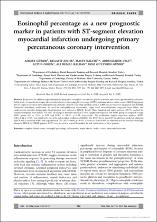| dc.contributor.author | Güner, Ahmet | |
| dc.contributor.author | Zehir, Regayip | |
| dc.contributor.author | Kalçık, Macit | |
| dc.contributor.author | Uslu, Abdulkadir | |
| dc.contributor.author | Ösken, Altuğ | |
| dc.contributor.author | Kalkan, Ali Kemal | |
| dc.contributor.author | Gültekin Güner, Ezgi | |
| dc.date.accessioned | 2021-11-01T15:02:56Z | |
| dc.date.available | 2021-11-01T15:02:56Z | |
| dc.date.issued | 2019 | |
| dc.identifier.citation | Güner, A., Zehİr, R., KalçIk, M., Uslu, A., Ösken, A., Kalkan, A. K., & Güner, E. G. (2020). Eosinophil percentage as a new prognostic marker in patients with ST-segment elevation myocardial infarction undergoing primary percutaneous coronary intervention. Interventional Medicine and Applied Science, 11(3), 146-153. | en_US |
| dc.identifier.issn | 2061-1617 | |
| dc.identifier.issn | 2061-5094 | |
| dc.identifier.uri | https://doi.org/10.1556/1646.11.2019.17 | |
| dc.identifier.uri | https://hdl.handle.net/11491/6869 | |
| dc.description.abstract | Background: In addition to proinflammatory properties, eosinophils can stimulate platelet activation and enhance prothrombotic pathways. In this study, we aimed to investigate the association between the eosinophil percentage (EOS%) and major adverse cardiac events (MACE) in patients with ST-segment elevation myocardial infarction (STEMI). Methods: This study enrolled a total of 1,909 patients who were diagnosed with STEMI. Ventricular arrhythmia, reinfarction, the need for cardiopulmonary resuscitation, target vessel revascularization, congestive heart failure, and cardiovascular mortality during index hospitalization were defined as MACE. Results: Three hundred and eighty patients (19.7%) reached the combined endpoint with MACE. The rates of inhospital mortality and MACE were significantly higher in low EOS% group as compared to high EOS% group (4% vs. 1.1%, p < 0.01 and 32.8% vs. 11.3%, p < 0.01, respectively). On multivariate logistic regression analyses, EOS% (OR = 0.44, p < 0.01) was found to be one of the independent predictors of MACE. The EOS% lower than 0.60 on admission predicted inhospital MACE with a sensitivity of 68% and a specificity of 72% (AUC: 0.684, p < 0.01). Conclusions: Low EOS% on admission may be associated with high inhospital MACE in STEMI patients. EOS% may be used as a novel biomarker for risk stratification of these patients. | en_US |
| dc.language.iso | eng | en_US |
| dc.publisher | Akademiai Kiado Zrt | en_US |
| dc.relation.ispartof | Interventional Medicine And Applied Science | en_US |
| dc.rights | info:eu-repo/semantics/openAccess | en_US |
| dc.subject | Complete Blood Counts | en_US |
| dc.subject | Eosinophil Percentage | en_US |
| dc.subject | Inflammation | en_US |
| dc.subject | Major Adverse Cardiac Events | en_US |
| dc.subject | Myocardial Infarction | en_US |
| dc.title | Eosinophil percentage as a new prognostic marker in patients with ST-segment elevation myocardial infarction undergoing primary percutaneous coronary intervention | en_US |
| dc.type | article | en_US |
| dc.department | Hitit Üniversitesi, Tıp Fakültesi, Dahili Tıp Bilimleri Bölümü | en_US |
| dc.identifier.volume | 11 | en_US |
| dc.identifier.issue | 3 | en_US |
| dc.identifier.startpage | 146 | en_US |
| dc.identifier.endpage | 153 | en_US |
| dc.relation.publicationcategory | Makale - Uluslararası Hakemli Dergi - Kurum Öğretim Elemanı | en_US |
| dc.department-temp | [Guner, Ahmet; Uslu, Abdulkadir] Kartal Kosuyolu Training & Res Hosp, Dept Cardiol, Istanbul, Turkey; [Zehir, Regayip; Osken, Altug] Siyami Ersek Thorac & Cardiovasc Surg Training &, Dept Cardiol, Istanbul, Turkey; [Kalcik, Macit] Hitit Univ, Fac Med, Dept Cardiol, Buhara 25 Sok 1,A Daire 22, Corum, Turkey; [Kalkan, Ali Kemal; Guner, Ezgi Gultekin] Mehmet Akif Ersoy Thorac & Cardiovasc Surg Traini, Dept Cardiol, Istanbul, Turkey | en_US |
| dc.contributor.institutionauthor | Kalçık, Macit | |
| dc.identifier.doi | 10.1556/1646.11.2019.17 | |
| dc.authorwosid | Ösken, Altuğ / AAW-7198-2021 | |
| dc.description.wospublicationid | WOS:000576384300004 | en_US |
| dc.description.scopuspublicationid | 2-s2.0-85094136401 | en_US |


















